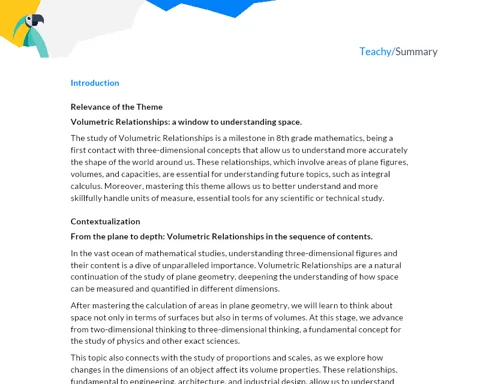Indirect Rule of 3 Problems | Socioemotional Summary
Objectives
1. Understand the concept of indirect proportion and its application in mathematical problems.
2. Identify and solve problems involving inversely proportional quantities.
3. Develop socioemotional skills, such as resilience and collaboration.
Contextualization
🎯 Imagine you are leading a volunteer project to distribute food! The more volunteers you have, the less work each person needs to do. On the other hand, if there are fewer volunteers, each one will have to work harder. This inverse relationship is a classic example of indirect proportion. Understanding these relationships not only helps in everyday situations but also develops crucial problem-solving and critical thinking skills. 🌱
Important Topics
Definition of Indirect Proportion
Indirect proportion is used to solve problems where two quantities are inversely proportional. This means that when one quantity increases, the other decreases in the same proportion. This concept is crucial for understanding everyday situations, from dividing tasks in a group to calculating travel times. With practice, you will be able to quickly identify these relationships and apply the correct solution to problems.
-
Inversely Proportional Quantities: If one quantity increases, the other decreases. For example: More workers, less time to complete a task.
-
Inverse Proportion: The multiplication of two inversely proportional quantities is constant. In other words, if one doubles, the other is halved.
-
Problem Solving: Involves setting up a proportion and solving a simple equation. It helps develop logical reasoning and critical thinking skills.
Example Problem
Let's understand through a practical example. Suppose 4 workers can complete a task in 6 hours. How many workers would be needed to complete the same task in 3 hours? The resolution involves identifying the quantities, setting up the inverse proportion, and solving the equation. This teaches us to apply the technique to real situations, as well as developing patience and resilience in facing mathematical challenges.
-
Identification of Quantities: Recognize which quantities are related inversely. In the example, 'number of workers' and 'time'.
-
Setting Up the Inverse Proportion: Construct the inverse equation (4 workers x 6 hours = n workers x 3 hours).
-
Solving the Equation: Solve the equation to find the unknown quantity (n = 8). Developing this skill reinforces logical reasoning and analytical thinking.
Analogies to Facilitate Understanding
Using analogies can make learning more accessible and engaging. Imagine an air balloon: when you squeeze one side, the other expands. This visualization can help understand how quantities behave inversely. Analogies like this not only facilitate understanding but also make learning more enjoyable and less stressful.
-
Air Balloon: Squeezing one side makes the other side expand, illustrating the inverse relationship.
-
Two-Plate Scale: Adding more weight to one plate causes the other to rise, demonstrating inverse proportionality.
-
Mental Mazes: Analogies help simplify complex concepts, promoting self-confidence and mental clarity.
Key Terms
-
Indirect Proportion: Technique for solving problems where two quantities are inversely proportional.
-
Inversely Proportional: Relationship where when one quantity increases, the other decreases in the same proportion.
-
Inverse Proportion: Equation that represents the constant relationship between two inversely proportional quantities.
To Reflect
-
How can you apply the concept of indirect proportion in everyday situations beyond the examples given? Provide a specific example.
-
Reflect on a situation where facing a mathematical problem generated frustration. How did you deal with that emotion? What would you do differently with the knowledge of resilience?
-
How did collaborating with your peers during the group activity help solve the problem? What social skills did you notice you developed or need to improve?
Important Conclusions
-
Indirect proportion is an essential tool for solving problems where two quantities are inversely proportional.
-
Understanding these relationships allows practical solutions to be applied in everyday situations and develops skills in logical reasoning and critical thinking.
-
In addition to mathematical knowledge, practicing indirect proportion strengthens socioemotional competencies such as resilience and collaboration.
Impact on Society
Understanding indirect proportion has a great impact on our daily lives. From managing tasks in groups to organizing events, knowing how one quantity inversely affects another makes problem-solving much more efficient. For example, knowing how many people are needed to complete a task in less time allows us to organize work more effectively and productively. This not only improves individual performance but also that of the entire team, fostering an environment of cooperation and efficiency.
By developing socioemotional skills, such as resilience and collaboration through the practice of indirect proportion, you are also preparing to face emotional challenges. When you encounter complex problems and feel frustration, the ability to recognize that emotion and work with it facilitates problem resolution. Resilience allows you to maintain motivation and focus, while collaboration with peers strengthens understanding and collective problem-solving, giving an even deeper emotional meaning to mathematical learning.
Dealing with Emotions
To practice the RULER method at home, take a few minutes after a study session to reflect on your emotions. First, recognize how you felt during your study – was it frustrating, challenging, or rewarding? Understand the causes of these emotions, perhaps the difficulty of the problem or the satisfaction of finding a solution. Correctly name these emotions, such as anxiety or joy. Express your emotions by writing in a journal or talking with a friend about your experience. Finally, regulate these emotions using deep breathing techniques or strategic breaks, helping you to stay calm and focused on your studies.
Study Tips
-
Practice regularly by solving different types of indirect proportion problems to solidify your understanding.
-
Work in groups whenever possible; collaboration with peers can bring new perspectives and innovative solutions.
-
Use analogies and visualizations to better understand the abstract concepts of inversely proportional quantities. This makes learning lighter and more enjoyable.



